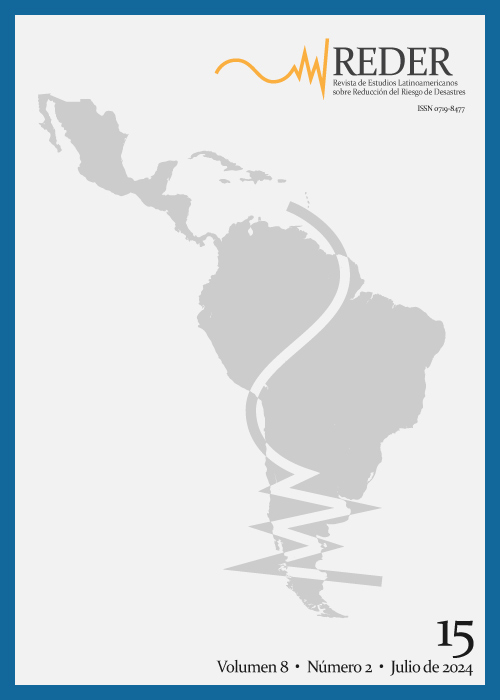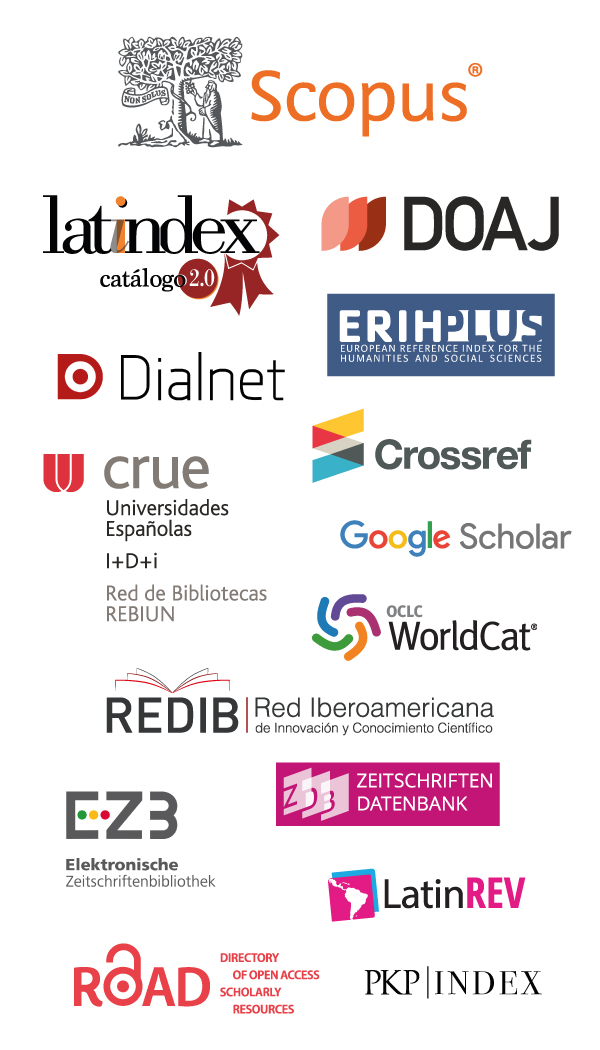Evaluación de la vulnerabilidad social a los peligros naturales en Nova Friburgo, Región Montañosa de Rio de Janeiro, Brasil
DOI: https://doi.org/10.55467/reder.v3i2.33
Resumen
Palabras clave
Texto completo:
PDFReferencias
Anazawa, T., Feitosa, F. & Monteiro, A. (2013). Vulnerabilidade socioecológica no litoral norte de São Paulo: medidas, superfícies e perfis de ativos. Revista Geografia, 38(1), 189-208.
Anselin, L. (1995). Local Indicators of Spatial Association - LISA. Geographical Analysis, 27(2), 93-115. Ashley, S.T. & Ashley, W. S. (2008). Flood fatalities in the United States. Journal of Applied Meteorology and Climatology, 47, 805-818.
Avelar, A.S., Coelho Netto, A.L., Lacerda, W.A., Becker, L.B. & Mendonça, M.B. (2011). Mechanisms of the recent catastrophic landslides in the mountainous range of Rio de Janeiro, Brazil. In II World Landslide Forum. Rome: WLF.
Birkmann, J. (2006). Indicators and criteria for measuring vulnerability: theoretical basis and requirements. In Birkmann, J. (Ed.) Measuring vulnerability to natural hazards towards disaster resilient societies. Tokyo: United Nations University Press.
Blaikie, P., Cannon, T., Davis, I. & Wisner, B. (1994). At risk: natural hazards, people’s vulnerability and disasters. London: Routledge.
Bogardi, J. & Birkmann, J. (2004). Vulnerability assessment: The first step towards Sustainable Risk Reduction. In Malzahn, D. & Plapp, T (Eds). Disaster and Society: from Hazard assessment to Risk reduction. Berlin: Logos Verlag Berlin, pp. 75-82.
Bohle, H.G. (2001). Vulnerability and Criticality: Perspectives from Social Geography. Newsletter of the International Human Dimensions Programme on Global Environmental Change, 2, 1-7.
Busch, A. & Amorim, S. (2011). A tragédia da Região Serrana do Rio de Janeiro em 2011: procurando respostas. ENAP-Casoteca de Gestão Pública, 328(1), 1-20.
Camarinha, P.I., Canavasi, V. & Alvalá, S. (2014). Shallow landslide prediction and analysis with risk assessment using a spatial model in a coastal region in the State of São Paulo, Brazil. Natural Hazards and Earth System Science, 14, 2449-2468.
Campante, F.R., Crespo, A.R. & Leite, G.P. (2004). Desigualdade salarial entre raças no mercado de trabalho urbano brasileiro: aspectos regionais. Revista Brasileira de Economia, 58(2), 185-210.
Cardona, O.D. (1999). Environmental management and disaster prevention: two related topics: a holistic risk assessment and management approach. In Ingleton, J. (Ed.) Natural Disaster Management. London: Tudor Rose.
Cardozo, C.P., Monteiro, A.M.V., Freitas, C.M. & Lopes, E. S. (2017). Intra- urban differentials in the exposition and vulnerability to landslides: the Human Fatalities in the 2011 Nova Friburgo - RJ disaster. In the Camaden (Ed.) First Brazilian Workshop on Assessment of Hazards, Vulnerability, Exposure and Disaster Risk Reduction. São José dos Campos: Cemaden.
Cardozo, C.P., Lopes, E. S. & Monteiro, A.M.V. (2018). Shallow landslide susceptibility assessment using SINMAP in Nova Friburgo (Rio de Janeiro, Brazil). Revista Brasileira de Cartografia, 70(4), 1206-1230.
Carmo, R. L., Dagnino, R.S. & Johansen, I. C. (2014). Transição demográfica e transição do consumo urbano de água no Brasil. Revista Brasileira de Estudos de População, 31(1), 169-190.
Castilho, L.V., Oliveira, P. & Fabriani, E.C. (2012). Análise de uma tragédia ambiental e a participação da população no equacionamento dos problemas de moradia: um estudo de caso da tragédia na Região Serrana do Rio de Janeiro. In VI National ANPASS Meeting. Belem: Universidade de Para.
Cerny, C.A. & Kaiser, H.F. (1977). A study of a measure of sampling adequacy for factor-analytic correlation matrices. Multivariate Behavioral Research, 12(1), 43-47.
Chambers, R. (1989). Vulnerability: How the poor cope. IDS Bulletin, 20(2), 1-7.
Coelho Netto, A. L., Sato, A. M., Avelar, A. S., Vianna, L. G., Araújo, I. S., Ferreira, D. L., Lima, P.H., Silva, A. P. & Silva, R. (2011). January 2001: The extreme landslide disaster in Brazil. In II World Landslide Forum. Rome: WLF.
Costa, M.A. & Marguti B. (Eds.). (2015). Atlas da Vulnerabilidade Social nos municípios brasileiros. Brasília: Instituto de Pesquisa Econômica Aplicada IPEA. Brasilia: IPEA.
Cutter, S.L., Boruff, B.J. & Shirley, W.L. (2003). Social vulnerability to environmental hazards. Social Science Quarterly, 84(2), 242-261.
Cutter S. L. & Finch, C. (2008). Temporal and spatial changes in social vulnerability to natural hazards. Proceedings of the National Academy of Sciences of the United States of America, 105(7), 2301-2306.
Cutter, S.L. & Morath, D.P. (2013). The evolution of the Social Vulnerability Index. In Birkmann, J. (Ed.). Measuring vulnerability to natural hazards. Bonn: United Nations University Press, pp. 304-321.
Presidência da República, Brasil. (2003). Elderly Statute. Law N° 10.741. Presidência da República [web]. Available in: http://www.planalto.gov.br/ccivil_03/leis/2003/L10.741.htm [Accessed 25 Jun 2017].
Ferreira, G.S. (2016). Expansão da população asiática no Brasil e no Rio Grande do Sul (2000–2010). Boletim Geográfico do Rio Grande do Sul, 28, 124-139.
Freitas, C.M., Carvalho, M.L., Ximenes, E.F., Arraes, E. & Gomes, J.O. (2012). Vulnerabilidade socioambiental, redução de riscos de desastres e construção da resiliência – lições do terremoto no Haiti e das chuvas fortes na Região Serrana, Brasil. Revista Ciência e Saúde Coletiva, 17(6), 1577-1586.
Fuchs, S. (2009). Susceptibility versus resilience to mountain hazards in Austria - paradigms of vulnerability revisited. Natural Hazards and Earth System Science, 9, 337-352.
Gautam, D. (2017). Assessment of social vulnerability to natural hazards in Nepal. Natural Hazards and Earth System Science, 17, 2313-2320.
Gonçalves, A.J. (2001). Migrações Internas: evoluções e desafios. Estudos Avançados, 15(43), 173-184.
Hummell, B.M., Cutter, S.L. & Emrich, C.T. (2016). Social vulnerability to natural hazards in Brazil. International Journal of Disaster Risk Science, 7, 111-122.
Brazilian Institute of Geography & Statistics IBGE. (2010). 2010 Census. IBGE [web]. Available in:
www.ibge.gov.br/home/estatistica/populacao/censo2010/default.shtm" target="_blank">http://
www.ibge.gov.br/home/estatistica/populacao/censo2010/default.shtm [Accessed 10 Mar. 2016].
Brazilian Institute of Geography & Statistics IBGE. (2011). Press room November 19, 2011. Available in: http://saladeimprensa.ibge.gov.br/en/notic... [Accessed 11 Aug 2017].
Kaiser, H. (1958). The Varimax criterion for analytic rotation in factor analysis. Psychometrika, 23, 187-200.
Menoni, S., Molinari, D., Parker, D., Ballio, F. & Tapsell, S. (2012). Assessing multifaceted vulnerability and resilience in order to design risk-mitigation strategies. Natural Hazards, 64(3), 2057-2082.
Moran, P. (1948). The interpretation of statistical maps. Journal of the Royal Statistical Society, Series B-Methodological, 10, 243-251.
Nathan, F. (2005). Vulnerabilities to natural hazard: Case study on landslide risk in La Paz. In Proceedings of the World International Studies Conference. Istambul: Bilgi University.
Nery, T.D. & Vieira, B.C. (2014). Susceptibility to shallow landslides in a drainage basin in the Serra do Mar, São Paulo, Brazil, predicted using the SINMAP mathematical model. Bulletin of Engineering Geology Environment, 74(2), 369-378.
Parker, D. & Tapsell, S. (2009). Relations between different types of social and economic vulnerability. EU Project “Enhancing resilience of communities and territories facing natural and na-tech hazards” (ENSURE). Final Report.
Rigout, F., Martin, C., Simioni, A.P., Martinho, J., Zackiewicz, M. & Mansour, V. (2015). Diagnóstico municipal: Trabalho infantil em Nova Friburgo. São Paulo: Technical Report.
Departamento de Recursos Minerais - Rio de Janeiro DRM-RJ. (2015). Cartografia geotécnica de aptidão urbana Nova Friburgo. Escala 1:10.000. Rio de Janeiro: Geological Survey of the State of Rio de Janeiro Report.
Roberts N.J., Nadim, F. & Kalsnes, B. (2007). Quantification of vulnerability to natural hazards. In ISGSR2007. First International Symposium on Geotechnical Safety & Risk. Shangai: Tongji University.
Roncancio, D.J. & Nardocci, A.C. (2016). Social vulnerability to natural hazards in São Paulo, Brazil. Natural Hazards, 84, 1367-1383.
Sharif, H., Jackson, T., Hossain, M. & Zane, D. (2015). Analysis of flood fatalities in Texas. Natural Hazards Review, 16(1), 1-8.
Snedecor, G.W. & Cochran, W.G. (1989). Statistical methods. Iowa State University Press: Ames.
Tapsell, S., McCarthy, S., Faulkner, H. & Alexander, M. (2010). Social vulnerability and natural hazards. London: Middlesex University Press.
Turner, B.L., Kasperson, R.E., Matson, P.A., McCarthy, J.J., Corell, R.W., Christensen, L., Eckley, N., Kasperson, J.X., Luerse, A., Martello, M.L., Polsky, C., Pulsiph, A. & Schiller, A. (2003). A framework for vulnerability analysis in sustainability science. Proceedings of the National Academy of Science of the United States of America, 100(14), 8074-8079.
United Nations International Strategy for Disaster Reduction UNISDR. (2015). Sendai Framework for Action 2015–2030. Geneva: UNISDR.
Van Westen, C.J. (2000). Remote sensing for natural disaster management. International Archives of Photogrammetry and Remote Sensing, 33(7), 1609-1617.
Van Westen, C.J., Alkema, D., Damen, M.C., Kerle, N. & Kingma, N.C. (2011). Multi-hazard risk assessment. Tokyo: United Nations University Press.
Van Westen, C.J. (2013). Remote sensing and GIS for natural hazards assessment and disaster risk management. Treatise on Geomorphology, 3, 259-298.
Vassoler, R. (2013). Ações da vigilância epidemiológica nos desastres naturais. Experiência na Região Serrana em 2011. Technical Report.
Willis, I., & Fitton, J. (2016). A review of multivariate social vulnerability methodologies: A case study of the River Parrett catchment, UK. Natural Hazards and Earth System Science, 16, 1387-1399.
Wisner, B. (2016). Vulnerability as concept, model, metric and tool. In Oxford Research Encyclopedia of Natural Hazard Science. New York: Oxford University Press.
Wisner, B., Blaikie, P.M., Cannon, T. & Davis, I. (2004). At risk: natural hazards, people's vulnerability and disasters. London and New York: Routledge.
World Bank. (2000). Infrastructure and poverty. New York: World Bank.
World Bank. (2012). Avaliação de perdas e danos: inundações e deslizamentos na Região Serrana do Rio de Janeiro. New York: World Bank Technical Report.
Enlaces refback
- No hay ningún enlace refback.








